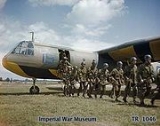
Airspeed Horsa
Encyclopedia
The Airspeed AS.51 Horsa was a British
United Kingdom
The United Kingdom of Great Britain and Northern IrelandIn the United Kingdom and Dependencies, other languages have been officially recognised as legitimate autochthonous languages under the European Charter for Regional or Minority Languages...
World War II
World War II
World War II, or the Second World War , was a global conflict lasting from 1939 to 1945, involving most of the world's nations—including all of the great powers—eventually forming two opposing military alliances: the Allies and the Axis...
troop-carrying glider built by Airspeed Limited and subcontractors and used for air assault by British and Allied
Allies
In everyday English usage, allies are people, groups, or nations that have joined together in an association for mutual benefit or to achieve some common purpose, whether or not explicit agreement has been worked out between them...
armed forces. It was named after Horsa, the legendary 5th century conqueror of southern Britain.
Development
The German military was one of the pioneers of the use of airborne operations, conducting several successful operations during the Battle of FranceBattle of France
In the Second World War, the Battle of France was the German invasion of France and the Low Countries, beginning on 10 May 1940, which ended the Phoney War. The battle consisted of two main operations. In the first, Fall Gelb , German armoured units pushed through the Ardennes, to cut off and...
in 1940, including the Battle of Fort Eben-Emael
Battle of Fort Eben-Emael
The Battle of Fort Eben-Emael was a battle between Belgian and German forces that took place between 10 May and 11 May 1940, and was part of the Battle of the Netherlands, Battle of Belgium and Fall Gelb, the German invasion of the Low Countries and France...
. Impressed by the success of German airborne operations, the Allied governments decided to form their own airborne formations. This decision would eventually lead to the creation of two British airborne divisions, as well as a number of smaller units. The British airborne establishment began development on 22 June 1940, when the Prime Minister
Prime Minister of the United Kingdom
The Prime Minister of the United Kingdom of Great Britain and Northern Ireland is the Head of Her Majesty's Government in the United Kingdom. The Prime Minister and Cabinet are collectively accountable for their policies and actions to the Sovereign, to Parliament, to their political party and...
, Winston Churchill
Winston Churchill
Sir Winston Leonard Spencer-Churchill, was a predominantly Conservative British politician and statesman known for his leadership of the United Kingdom during the Second World War. He is widely regarded as one of the greatest wartime leaders of the century and served as Prime Minister twice...
, directed the War Office
War Office
The War Office was a department of the British Government, responsible for the administration of the British Army between the 17th century and 1964, when its functions were transferred to the Ministry of Defence...
in a memorandum to investigate the possibility of creating a corps
Corps
A corps is either a large formation, or an administrative grouping of troops within an armed force with a common function such as Artillery or Signals representing an arm of service...
of 5,000 parachute troops. In 1941, the United States embarked on a similar program.
When the equipment for the airborne forces was under development, it was decided by War Office officials that gliders would be an integral component of such a force; these would be used to transport troops and heavy equipment. The first glider to be designed and produced was the General Aircraft Hotspur, the first prototype of which flew on 5 November 1940. However, several problems were found with the Hotspur's design, the primary one being that the glider did not carry sufficient troops. Tactically it was believed that airborne troops should be landed in groups far larger than the eight the Hotspur could transport, and also the number of aircraft required to tow the gliders needed to carry larger groups would be impractical. There were also concerns that the gliders would have to be towed in tandem if used operationally, which would be extremely difficult during nighttime and through cloud formations. So it was decided to use the Hotspur as a training glider, and continue with the development of several other types of glider, including a 25-seater assault glider which became the Airspeed Horsa.

Armstrong Whitworth Whitley
The Armstrong Whitworth A.W.38 Whitley was one of three British twin-engine, front line medium bomber types in service with the Royal Air Force at the outbreak of the Second World War...
took flight on 12 September 1941 with George Errington at the controls, 11 months after the specification had been issued.
As specified in Specification X3/41, 200 AS 52 Horsas were also to be constructed to carry bombs. A central fuselage bomb bay holding four 2,000 lb or two 4,000 lb bombs was fitted into the standard Horsa fuselage. The concept of towing bombs was dropped as other bombers became available, with the order for the AS 52 cancelled.
Production of the Horsa commenced in early 1942, and by May some 2,345 had been ordered by the Army for use in future airborne operations. The glider was designed from the outset to be built in components with a series of 30 sub-assemblies required to complete the manufacturing process. Manufacturing was intended primarily to use woodcrafting facilities not needed for more urgent aviation production, and as a result production was spread across separate factories, which consequently limited the likely loss in case of German attack. The designer A. H. Tiltman
A. H. Tiltman
Arthur Hessell Tiltman FRAeS , known as Hessell Tiltman, was a notable British aircraft designer, and co-founder of Airspeed Ltd....
said that the Horsa "went from the drawing board to the air in ten months, which was not too bad considering the drawings had to be made suitable for the furniture trade who were responsible for all production."
The initial 695 gliders were manufactured at Airspeed's factory in Christchurch, Hants, with subcontractors producing the remainder. These included Austin Motors
Austin Motor Company
The Austin Motor Company was a British manufacturer of automobiles. The company was founded in 1905 and merged in 1952 into the British Motor Corporation Ltd. The marque Austin was used until 1987...
and the furniture
Furniture
Furniture is the mass noun for the movable objects intended to support various human activities such as seating and sleeping in beds, to hold objects at a convenient height for work using horizontal surfaces above the ground, or to store things...
manufacturers Harris Lebus
Harris Lebus
Harris Lebus was a very large furniture manufacturer and wholesaler based in the East End of London in Tabernacle St with a factory in Tottenham...
. The subcontractors did not have airfields to deliver the gliders from, and sent the sub-assemblies to RAF Maintenance Units for final assembly. Between 3,799 and approximately 5,000 Horsas were built when production ended.Precise figures for the total number of Horsas produced varies between sources. Mondey (p. 15) gives the figure of 3,799, Flint (p. 56) and Lynch (p. 203) give the number of 3,655, whilst Smith (p. 15) gives a larger total of "over 5,000."
Design
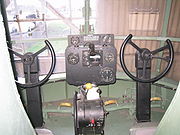
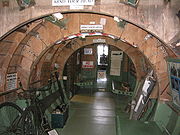
The Horsa was considered sturdy and very manoeuvrable for a glider. Its design was based on a high-wing cantilever monoplane with wooden wings and a wooden semi-monocoque
Monocoque
Monocoque is a construction technique that supports structural load by using an object's external skin, as opposed to using an internal frame or truss that is then covered with a non-load-bearing skin or coachwork...
fuselage. The fuselage was built in three sections bolted together, the front section held the pilot's compartment and main freight loading door, the middle section was accommodation for troops or freight, the rear section supported the tail unit. It had a fixed tricycle landing gear and it was one of the first gliders equipped with a tricycle undercarriage for take off. On operational flights the main gear could be jettisoned and landing was then made on the castoring nose wheel and a sprung
Spring (device)
A spring is an elastic object used to store mechanical energy. Springs are usually made out of spring steel. Small springs can be wound from pre-hardened stock, while larger ones are made from annealed steel and hardened after fabrication...
skid under the fuselage.
The wing carried large "barn door" flap
Flap (aircraft)
Flaps are normally hinged surfaces mounted on the trailing edges of the wings of a fixed-wing aircraft to reduce the speed an aircraft can be safely flown at and to increase the angle of descent for landing without increasing air speed. They shorten takeoff and landing distances as well as...
s which, when lowered, made a steep, high rate-of-descent landing possible — allowing the pilots to land in constricted spaces. The pilot's compartment had two side-by-side seats and dual controls. Aft of the pilot's compartment was the freight loading door on the port side. The hinged door could also be used as a loading ramp. The main compartment could accommodate 15 troops on benches along the sides with another access door on the starboard side. The fuselage joint at the rear end of the main section could be broken on landing to assist in rapid unloading of troops and equipment. Supply containers could also be fitted under the centre-section of the wing, three on each side. The later AS 58 Horsa II had a hinged nose section, reinforced floor and double nose wheels to support the extra weight of vehicles. The tow cable was attached to the nose wheel strut, rather than the dual wing points of the Horsa I.
The Airborne Forces Experimental Establishment and 1st Airlanding Brigade began loading trials with the prototypes in March but immediately ran into problems. Staff attempted to fit a jeep into a prototype, only to be told by Airspeed personnel present that to do so would break the glider's loading ramp, as it had only been designed to hold a single motorbike. With this lesson learnt, 1st Airlanding Brigade subsequently began sending samples of all equipment required to go into Horsas to Airspeed, and a number of weeks were spent ascertaining the methods and modifications required to fit the equipment into a Horsa.
Operational history
With up to 30 troop seats, the Horsa was much bigger than the 13-troop American Waco CG-4A (known as the Hadrian by the British), and the 8-troop General Aircraft Hotspur glider which was intended for training duties only. Instead of troops, the AS 51 could carry a jeepJeep
Jeep is an automobile marque of Chrysler . The first Willys Jeeps were produced in 1941 with the first civilian models in 1945, making it the oldest off-road vehicle and sport utility vehicle brand. It inspired a number of other light utility vehicles, such as the Land Rover which is the second...
or a 6 pounder anti tank gun
Artillery
Originally applied to any group of infantry primarily armed with projectile weapons, artillery has over time become limited in meaning to refer only to those engines of war that operate by projection of munitions far beyond the range of effect of personal weapons...
.
The Horsa was first used operationally on the night of 19/20 November 1942 in the unsuccessful attack on the German Heavy Water
Heavy water
Heavy water is water highly enriched in the hydrogen isotope deuterium; e.g., heavy water used in CANDU reactors is 99.75% enriched by hydrogen atom-fraction...
Plant at Rjukan
Rjukan
Rjukan is a town and the administrative center of Tinn municipality in Telemark . It is situated in Vestfjorddalen, between Møsvatn and Tinnsjå, and got its name after Rjukanfossen west of the town. The Tinn municipality council granted township status for Rjukan in 1996. The town has 3 386...
in Norway
Norway
Norway , officially the Kingdom of Norway, is a Nordic unitary constitutional monarchy whose territory comprises the western portion of the Scandinavian Peninsula, Jan Mayen, and the Arctic archipelago of Svalbard and Bouvet Island. Norway has a total area of and a population of about 4.9 million...
(Operation Freshman
Operation Freshman
Operation Freshman was the codename given to a British airborne operation conducted in November 1942 during World War II. It was the first British airborne operation conducted using gliders, and its target was the Vemork Norsk Hydro chemical plant in Norway which produced heavy water for Nazi Germany...
). The two Horsa gliders, each carrying 15 sappers, and one of the Halifax
Handley Page Halifax
The Handley Page Halifax was one of the British front-line, four-engined heavy bombers of the Royal Air Force during the Second World War. A contemporary of the famous Avro Lancaster, the Halifax remained in service until the end of the war, performing a variety of duties in addition to bombing...
tug aircraft, crashed in Norway due to bad weather. All 23 survivors from the glider crashes were executed on the orders of Hitler
Adolf Hitler
Adolf Hitler was an Austrian-born German politician and the leader of the National Socialist German Workers Party , commonly referred to as the Nazi Party). He was Chancellor of Germany from 1933 to 1945, and head of state from 1934 to 1945...
, in direct breach of the Geneva Convention which protects POWs from summary execution
Summary execution
A summary execution is a variety of execution in which a person is killed on the spot without trial or after a show trial. Summary executions have been practiced by the police, military, and paramilitary organizations and are associated with guerrilla warfare, counter-insurgency, terrorism, and...
.
In preparation for further operational deployment, 30 Horsa gliders were air-towed by Halifax bombers from Great Britain to North Africa but three aircraft were lost in transit. On 10 July 1943, 27 surviving Horsas were used in Operation Husky, the invasion of Sicily
Sicily
Sicily is a region of Italy, and is the largest island in the Mediterranean Sea. Along with the surrounding minor islands, it constitutes an autonomous region of Italy, the Regione Autonoma Siciliana Sicily has a rich and unique culture, especially with regard to the arts, music, literature,...
. Large numbers (estimated at over 250) were subsequently used in Battle of Normandy
Operation Overlord
Operation Overlord was the code name for the Battle of Normandy, the operation that launched the invasion of German-occupied western Europe during World War II by Allied forces. The operation commenced on 6 June 1944 with the Normandy landings...
; in the British Operation Tonga
Operation Tonga
Operation Tonga was the codename given to the airborne operation undertaken by the British 6th Airborne Division between 5 June and 7 June 1944 as a part of Operation Overlord and the Normandy Landings during the Second World War....
and American operations
American airborne landings in Normandy
The American airborne landings in Normandy were the first United States combat operations during Operation Overlord, the invasion of Normandy by the Western Allies on June 6, 1944. Around 13,100 paratroopers of the U.S. 82nd Airborne and 101st Airborne Divisions made night parachute drops early on...
. The first units to land in France
France
The French Republic , The French Republic , The French Republic , (commonly known as France , is a unitary semi-presidential republic in Western Europe with several overseas territories and islands located on other continents and in the Indian, Pacific, and Atlantic oceans. Metropolitan France...
, during the Battle of Normandy, was a coup de main force carried by 6 Horsas that captured Pegasus Bridge
Pegasus Bridge
Pegasus Bridge is a bascule bridge , built in 1934, that crossed the Caen Canal, between Caen and Ouistreham, in Normandy, France....
in Operation Deadstick
Operation Deadstick
Operation Deadstick was the codename for an airborne forces operation by the British Army that took place on 6 June 1944 as part of the Normandy landings. The mission's objective was to capture intact two road bridges in Normandy across the River Orne and the Caen Canal providing the only exit...
, over the Caen canal, and a further bridge over the River Orne. 320 Horsas were used in the first lift and a further 296 Horsas were used in the second lift.
Large numbers were also used for Operation Dragoon
Operation Dragoon
Operation Dragoon was the Allied invasion of southern France on August 15, 1944, during World War II. The invasion was initiated via a parachute drop by the 1st Airborne Task Force, followed by an amphibious assault by elements of the U.S. Seventh Army, followed a day later by a force made up...
and Operation Market Garden
Operation Market Garden
Operation Market Garden was an unsuccessful Allied military operation, fought in the Netherlands and Germany in the Second World War. It was the largest airborne operation up to that time....
, both in 1944, and Operation Varsity
Operation Varsity
Operation Varsity was a successful joint American–British airborne operation that took place toward the end of World War II...
in March 1945; the final operation for the Horsa when 440 gliders carried soldiers of the 6th Airborne Division across the Rhine.
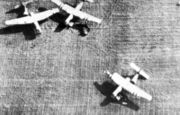
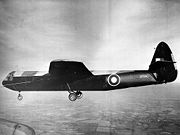
Short Stirling
The Short Stirling was the first four-engined British heavy bomber of the Second World War. The Stirling was designed and built by Short Brothers to an Air Ministry specification from 1936, and entered service in 1941...
and Handley Page Halifax
Handley Page Halifax
The Handley Page Halifax was one of the British front-line, four-engined heavy bombers of the Royal Air Force during the Second World War. A contemporary of the famous Avro Lancaster, the Halifax remained in service until the end of the war, performing a variety of duties in addition to bombing...
, the Armstrong Whitworth Albemarle
Armstrong Whitworth Albemarle
The Armstrong Whitworth A.W.41 Albemarle was a British twin-engine transport aircraft that entered service during the Second World War.Originally designed as a medium bomber that could be built by non-aviation companies without using light alloys, the Albemarle never served in that role, instead...
and Armstrong Whitworth Whitley
Armstrong Whitworth Whitley
The Armstrong Whitworth A.W.38 Whitley was one of three British twin-engine, front line medium bomber types in service with the Royal Air Force at the outbreak of the Second World War...
twin engined bombers, as well as the US Douglas C-47 Skytrain/Dakota
C-47 Skytrain
The Douglas C-47 Skytrain or Dakota is a military transport aircraft that was developed from the Douglas DC-3 airliner. It was used extensively by the Allies during World War II and remained in front line operations through the 1950s with a few remaining in operation to this day.-Design and...
(not as often due to the weight of the glider, however in Operation Market Garden, a total of 1,336 C-47s along with 340 Stirlings were employed to tow 1,205 gliders,) and Curtiss C-46 Commando
C-46 Commando
The Curtiss-Wright C-46 Commando was a transport aircraft originally derived from a commercial high-altitude airliner design. It was instead used as a military transport during World War II by the United States Army Air Forces as well as the U.S. Navy/Marine Corps under the designation R5C...
. They were towed with a harness that attached to points on both wings, and also carried an intercom between tug and glider. The glider pilots were usually from the Glider Pilot Regiment
Glider Pilot Regiment
The Glider Pilot Regiment was a British airborne forces unit of the Second World War which was responsible for crewing the British Army's military gliders and saw action in the European Theatre of World War II in support of Allied airborne operations...
, part of the Army Air Corps, although Royal Air Force
Royal Air Force
The Royal Air Force is the aerial warfare service branch of the British Armed Forces. Formed on 1 April 1918, it is the oldest independent air force in the world...
pilots were used on occasion.
The United States Army Air Forces
United States Army Air Forces
The United States Army Air Forces was the military aviation arm of the United States of America during and immediately after World War II, and the direct predecessor of the United States Air Force....
(USAAF) acquired approximately 400 Horsas in a form of "reverse" Lend-Lease. A small number of Horsa Mk IIs were obtained by the Royal Canadian Air Force
Royal Canadian Air Force
The history of the Royal Canadian Air Force begins in 1920, when the air force was created as the Canadian Air Force . In 1924 the CAF was renamed the Royal Canadian Air Force and granted royal sanction by King George V. The RCAF existed as an independent service until 1968...
for post-Second World War evaluation at CFB
Canadian Forces base
A Canadian Forces Base or CFB is a military installation of the Canadian Forces. For a facility to qualify as a Canadian Forces Base, it must station one or more major units .Minor installations are named Canadian Forces Station or CFS A Canadian Forces Base or CFB (French Base des forces...
Gimli, Manitoba
Gimli, Manitoba
Gimli is a a rural municipality located in the Interlake region of south-central Manitoba, Canada, on the western shore of Lake Winnipeg. It is about north of the provincial capital Winnipeg...
. Three of these survivors were purchased as surplus in the early 1950s and ended up in Matlock, Manitoba where they were eventually scrapped. A small number of Horsas were also evaluated postwar in India. Due to low surplus prices in the UK, many were bought and converted to travel trailers and vacation cottages.
On 5 June 2004, as part of the 60th anniversary commemoration of D-Day
D-Day
D-Day is a term often used in military parlance to denote the day on which a combat attack or operation is to be initiated. "D-Day" often represents a variable, designating the day upon which some significant event will occur or has occurred; see Military designation of days and hours for similar...
, Prince Charles
Charles, Prince of Wales
Prince Charles, Prince of Wales is the heir apparent and eldest son of Queen Elizabeth II and Prince Philip, Duke of Edinburgh. Since 1958 his major title has been His Royal Highness The Prince of Wales. In Scotland he is additionally known as The Duke of Rothesay...
unveiled a replica Horsa on the site of the first landing at Pegasus Bridge, and talked with Jim Wallwork
Jim Wallwork
Staff Sergeant Jim Wallwork DFM was a member of the Glider Pilot Regiment who achieved fame as the pilot of the first Horsa glider to land at Pegasus Bridge in the early hours of 6 June 1944. This remarkable achievement was described as "the greatest feat of flying of the second world war" by Air...
, the first pilot to land the aircraft on French soil during D-Day.
Ten replicas were built for use in the 1977 film A Bridge Too Far, mainly for static display and set-dressing, although one Horsa was modified to make a brief "hop" towed behind a Dakota at Deelen
Deelen
Deelen is a village in the Dutch province of Gelderland. It is largely located in the municipality of Ede, Netherlands, but a small part lies in the municipality of Arnhem.Deelen is best known for the Deelen Air Base, a military airfield close to the village....
, the Netherlands
Netherlands
The Netherlands is a constituent country of the Kingdom of the Netherlands, located mainly in North-West Europe and with several islands in the Caribbean. Mainland Netherlands borders the North Sea to the north and west, Belgium to the south, and Germany to the east, and shares maritime borders...
. During the production, seven of the replicas were damaged in a wind storm; the contingent were repaired in time for use in the film. Five of the Horsa "film models" were destroyed during filming with the survivors sold as a lot to John Hawke, aircraft collector in the UK. Another mock-up for close-up work came into the possession of the Ridgeway Military & Aviation Research Group and is stored at Welford, Berkshire.
Variants
AS.51 Horsa I- Production glider with cable attachment points at upper attachment points of main landing gear.
AS.52 Horsa
- Bomb-carrying Horsa; project cancelled prior to design/production
AS.53 Horsa
- further development of the horsa not taken up.
AS.58 Horsa II
- Development of the Horsa I with hinged nose, to allow direct loading and unloading of equipment, twin nose wheel and cable attachment on nose wheel strut.
Operators
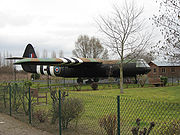
- Belgian ArmyBelgian ArmyThe Land Component is organised using the concept of capacities, whereby units are gathered together according to their function and material. Within this framework, there are five capacities: the command capacity, the combat capacity, the support capacity, the services capacity and the training...
- One aircraft only.
 Canada
Canada
- Royal Canadian Air ForceRoyal Canadian Air ForceThe history of the Royal Canadian Air Force begins in 1920, when the air force was created as the Canadian Air Force . In 1924 the CAF was renamed the Royal Canadian Air Force and granted royal sanction by King George V. The RCAF existed as an independent service until 1968...
- Indian Air ForceIndian Air ForceThe Indian Air Force is the air arm of the Indian armed forces. Its primary responsibility is to secure Indian airspace and to conduct aerial warfare during a conflict...
- Portuguese Air ForcePortuguese Air ForceThe Portuguese Air Force is the air force of Portugal. Formed on July 1, 1952, with the Aeronáutica Militar and Aviação Naval united in a single independent Air Force, it is one of the three branches of the Portuguese Armed Forces and its origins dates back to 1912, when the military aviation...
- Turkish Air ForceTurkish Air ForceThe Turkish Air Force is the aerial warfare service branch of the Turkish Armed Forces. It ranks 3rd in NATO in terms of fleet size behind the USAF and Royal Air Force with a current inventory of 798 aircraft .-Initial stages:...
- Army Air Corps
- Glider Pilot RegimentGlider Pilot RegimentThe Glider Pilot Regiment was a British airborne forces unit of the Second World War which was responsible for crewing the British Army's military gliders and saw action in the European Theatre of World War II in support of Allied airborne operations...
- Glider Pilot Regiment
- Royal Air ForceRoyal Air ForceThe Royal Air Force is the aerial warfare service branch of the British Armed Forces. Formed on 1 April 1918, it is the oldest independent air force in the world...
- No. 670 Squadron RAFNo. 670 Squadron RAFNo. 670 Squadron RAF was a glider squadron of the Royal Air Force active during the Second World War.-History:No. 670 Squadron was formed at Fatehjang, Punjab, British India on 14 December 1944 as a glider squadron, with the intention of being used for airborne operations by South East Asia...
- No. 670 Squadron RAF
- United States Army Air ForcesUnited States Army Air ForcesThe United States Army Air Forces was the military aviation arm of the United States of America during and immediately after World War II, and the direct predecessor of the United States Air Force....
Survivors
An Airspeed Horsa Mark II (KJ351) is preserved at the Museum of Army FlyingMuseum of Army Flying
The Museum of Army Flying is an award-winning British military aviation museum about the history of flying in the British Army. It is located beside the Army Air Corps Centre in Middle Wallop, close to Andover in Hampshire, England....
in Hampshire, England. The Assault Glider Trust
Assault Glider Trust
The Assault Glider Trust is a registered charity established in 2001 and based at RAF Shawbury in Shropshire.The trust was formed by veterans of the Glider Pilot Regiment Association...
is building a replica at RAF Shawbury
RAF Shawbury
RAF Shawbury is a Royal Air Force station by the village of Shawbury near Shrewsbury, Shropshire.The station at Shawbury was first used for military flying training in 1917 by the Royal Flying Corps, but it was returned to agricultural use in 1920. In 1938 it was reactivated as a training...
using templates made from original components found scattered over various European battlefields and using plans supplied by BAE Systems
BAE Systems
BAE Systems plc is a British multinational defence, security and aerospace company headquartered in London, United Kingdom, that has global interests, particularly in North America through its subsidiary BAE Systems Inc. BAE is among the world's largest military contractors; in 2009 it was the...
(on the condition that the glider is not flown).
Although there is some difference of opinion (now being researched), the replica at Pegasus bridge is believed to incorporate a forward fuselage section retrieved from Cholsey, Oxfordshire, England, which had served as a dwelling for over 50 years. This relic was recovered from Cholsey around 2001 by the Mosquito Aircraft Museum, of London Colney, where it was stored until being transferred to Pegasus Bridge. The airframe is not believed to have seen active service.

